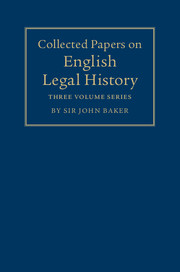Book contents
- Collected Papers on English Legal History: Volume I
- Contents
- List of Illustrations
- Acknowledments
- List of Abbreviations
- Introduction
- PART I The Legal Profession
- PART II The Inns of Court and Chancery
- 7 The Third University of England
- 8 The Inns of Court in 1388
- 9 The Division of the Temple: Inner, Middle and Outer
- 10 The Inn of the Outer Temple
- 11 The Old Constitution of Gray's Inn
- 12 The Ancient and Honourable Society of Gray's Inn
- 13 The Inns of Court and Chancery as Voluntary Associations
- 14 The Judges as Visitors to the Inns of Court
- PART III Legal Education
- PART IV Courts and Jurisdictions
- Collected Papers on English Legal History: Volume II
- Contents
- PART V Legal Literature
- PART VI Legal Antiquities
- PART VII Public Law and Individual Status
- PART VIII Criminal Justice
- Collected Papers on English Legal History: Volume III
- Contents
- PART IX Private Law
- PART X General
- Bibliography of the Published Works of Sir John Baker
- Index
9 - The Division of the Temple: Inner, Middle and Outer
from PART II - The Inns of Court and Chancery
Published online by Cambridge University Press: 05 December 2014
- Collected Papers on English Legal History: Volume I
- Contents
- List of Illustrations
- Acknowledments
- List of Abbreviations
- Introduction
- PART I The Legal Profession
- PART II The Inns of Court and Chancery
- 7 The Third University of England
- 8 The Inns of Court in 1388
- 9 The Division of the Temple: Inner, Middle and Outer
- 10 The Inn of the Outer Temple
- 11 The Old Constitution of Gray's Inn
- 12 The Ancient and Honourable Society of Gray's Inn
- 13 The Inns of Court and Chancery as Voluntary Associations
- 14 The Judges as Visitors to the Inns of Court
- PART III Legal Education
- PART IV Courts and Jurisdictions
- Collected Papers on English Legal History: Volume II
- Contents
- PART V Legal Literature
- PART VI Legal Antiquities
- PART VII Public Law and Individual Status
- PART VIII Criminal Justice
- Collected Papers on English Legal History: Volume III
- Contents
- PART IX Private Law
- PART X General
- Bibliography of the Published Works of Sir John Baker
- Index
Summary
As everyone knows, nothing for certain is known about the origin of the inns of court. The precise date and circumstances of the coming of the lawyers to the Temple have eluded historians, and are likely to do so for ever – unless the unsorted records of the knights hospitaller in Malta prove to contain the missing link. It is known that the lawyers were there by the 1350s, and it is probable that they were in by 1340; but it is unlikely that they could have been there – except perhaps for a few in-house lawyers or individual tenants – before 1308, when the Knights Templar were evicted. At the beginning of the intervening period it was still not certain that the king's central courts would regularly remain at Westminster, for they had been at York for several years under Edward I and would go there again in the 1320s. During such periods the lawyers following the courts would leave London, presumably to take lodgings in York, an exodus which cost the Fleet Street shopkeepers a considerable loss of revenue. While such uncertainty prevailed as to their usual place of work, the legal profession cannot have been greatly concerned to acquire permanent accommodation in London; and it is noteworthy that, in a recently discovered contract of 1323 to support a law student, the terms are not that he should be sent to some fixed location or institution but that he should be found for four years among the apprentices ‘at our lord the king's court of Common Bench, wherever the said Bench should be in England’.
- Type
- Chapter
- Information
- Collected Papers on English Legal History , pp. 173 - 180Publisher: Cambridge University PressPrint publication year: 2013



